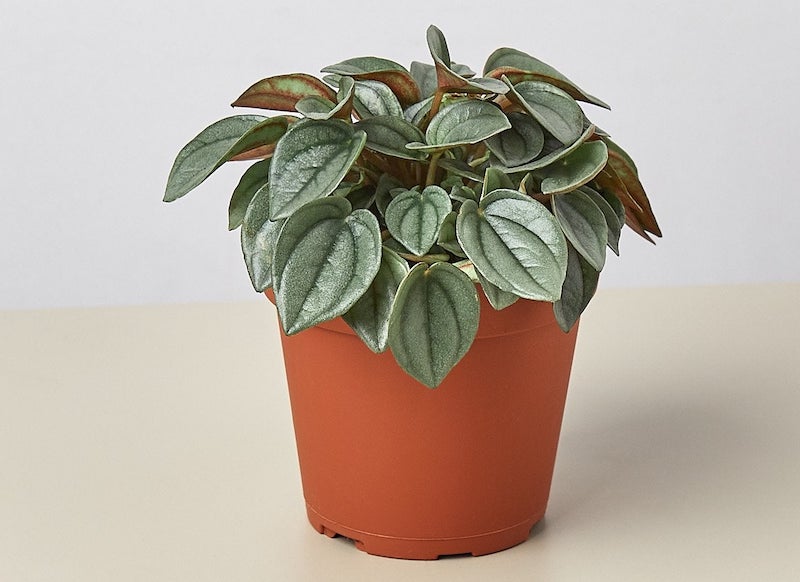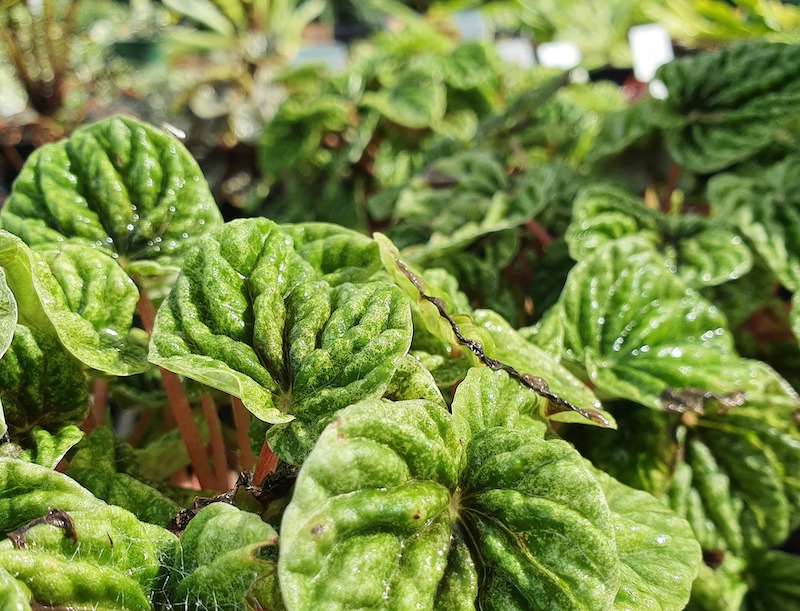Growing Peperomia
If you are into foliage, then the Peperomia is the houseplant for you. This leafy, easy-care plant has hundreds of different species and boasts leaves that are thick and fleshy, and can be smooth or textured, large or small. Leaves can be green, gray, purple, and some have red borders or pinstriping. Variegated or marbled varieties offer up even more visual interest. Also known as rubber plants or radiator plants, Peperomias are tropical and originate from Mexico, South America, and the Caribbean. These houseplants do best with a small amount of neglect, making them excellent for beginners or hands-off plant owners.

Peperomia Sunlight Requirements
The right location makes all the difference when it comes to growing Peperomias. These easy-care houseplants prefer bright indirect light. Plenty of light encourages new growth and enhances the colors for variegated cultivars. Peperomia plants can grow in medium indirect light, but the plant may grow more slowly and it can become leggy or have extended spaces between leaves. Place potted Peperomia plants in or near a south- or west-facing window so they can soak up lots of sunlight.
Planting Peperomia
Plant Peperomia houseplants in a soil mix that promotes drainage and is slightly acidic. This plant can happily live in basic potting soil, but expect best results from a loose mix with the proper pH. Soil formulated for orchids typically works well for Peperomias. There is no harm in letting Peperomia plants become slightly root bound. Transplant Peperomia to a larger container when the roots emerge at the top of the soil or poke through the drainage holes in the pot. It normally takes a few years for a plant to outgrow its container.
Watering Peperomia
Part of what makes Peperomias so appealing is the limited attention they require, and that is true when it comes to water requirements. Wait until the soil is dry before watering Peperomia plants. These plants store water in their thick, fleshy leaves, and they draw from this reserve as their roots dry out. Saturate the soil until excess water drains through the pot when it is time to water. Peperomia plants may be dormant during the winter, so they will require less water and may need a drink every 1 to 2 weeks. Peperomia plants like humid conditions, so place the plant in a damp area or use a pebble tray or humidifier to give this beauty some extra moisture.
Fertilizing Peperomia
Peperomia plants are not heavy feeders, so hold off on applying fertilizer. Plants grown in rich soil or a mix that contains a slow-release fertilizer will not need any supplemental feedings. This is a slow-growing plant that takes things at its own pace, and while giving it a helping hand can be tempting, it will not help the plant bulk up. Over-feeding Peperomias can be problematic, so less is more when it comes to feeding this houseplant.

Common Peperomia Problems
While Peperomia plants are low maintenance, take time to look at the plant for signs of distress. Yellow, curled, or drooping leaves indicate water stress. Browning around the outer edges can be a sign of low humidity. Plants grown in medium light can become straggly, so increase the light if the plant is sparse. Create a full plant by pinching back new growth, and prune the plant as needed to create a more rounded and ideal shape in the spring.
Propagating Peperomia
Peperomia plants can be propagated via cuttings, which can be collected during pruning. Remove a section of stem that has at least one leaf using a pair or sterilized shears. Place the cut end in damp soil and cover with plastic to keep the soil consistently moist. Roots should form in a few weeks. New plants have higher water needs, so keep them separate from the mother plant to start. Once the cutting starts to grow, it can be transplanted into the same container as the primary plant to create a full and dense look.

Growing Peperomia Outdoors
A summer outdoors can help Peperomia plants thrive, but remember that plants outdoors require slightly more attention. Peperomias are often touted as being low maintenance, and they are when grown inside. Move a potted Peperomia outside when the temperature is consistently above 50 degrees. Peperomias prefer a warm and steamy environment in a spot that receives indirect light. Use a pot that has drainage, so the roots are never left in standing water and only water if the soil is dry.
Plants We Recommend
 |
Author Alison Cotsonas - Published 03-02-2023 |
